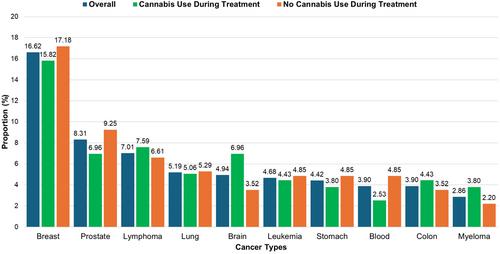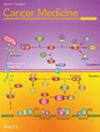Cannabis Use Among Cancer Patients During Active Treatment: Findings From a Study at an NCI-Designated Cancer Center
Abstract
Objective
This study aims to describe patterns, sources, and reasons for cannabis use among cancer patients during active treatment (+CDTX) compared to no-use during active treatment (−CDTX).
Methods
Data are from 385 surveys collected via REDCap during phase I of an ongoing study among adult cancer patients seen at an NCI-designated comprehensive cancer center within the last 5 years of treatment. A harmonized survey was created with 11 other NCI centers to assess cannabis use patterns, sources, and reasons for use. Sociodemographics and cancer details were also collected via self-report. Descriptive statistics were calculated and stratified by +/−CDTX. Chi-squared tests were conducted to compare proportions between groups.
Results
Among the sample [49.5 years (SD 15.9); 53.0% male; and 41.6% Hispanic/Latino], 41.0% + CDTX and 59.0% −CDTX. A majority (71.8%) of +CDTX initiated use before diagnosis versus 44.1% in −CDTX (p < 0.0001); patients diagnosed with stage 4 cancer had a statistically significant higher prevalence of +CDTX (60.0%; p = 0.003); 53.3% in radiation reported +CDTX compared to 42.8% in chemotherapy, and 36.4% in immunotherapy. Dispensaries and local dealers were the top sources of cannabis in both groups. Among +CDTX, 44.3% consumed cannabis at least once a day DTX, dominant cannabinoids used were CBD (35.2%), Delta-8-THC (18.3%), and CBD + THC ratio (14.1%); 12.7% were unsure what they consumed. Joints were the most common inhalation method (61.5%), and store-bought candy was the most common edible (39.2%). Depression/mood, pain, and enjoyment were the top three reasons for +CDTX compared to enjoyment, depression/mood, and nausea/upset stomach in −CDTX (p = 0.02).
Conclusions
Patterns, sources, and reasons for cannabis use varied between +CDTX and -CDTX. Future studies should examine the impacts of cannabis and specific cannabinoids on cancer treatment, drug interactions, survival outcomes, and quality of life.


 求助内容:
求助内容: 应助结果提醒方式:
应助结果提醒方式:


